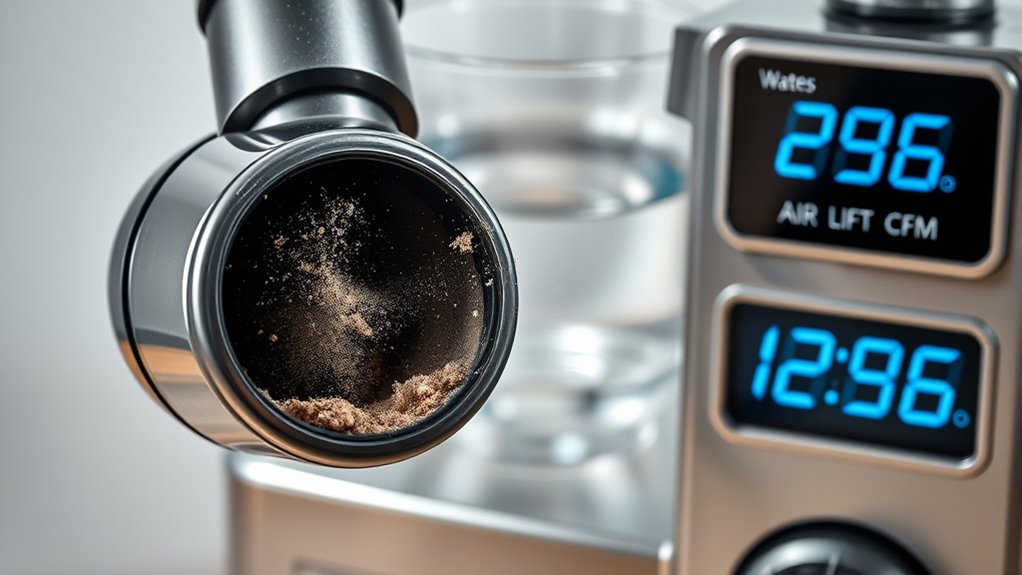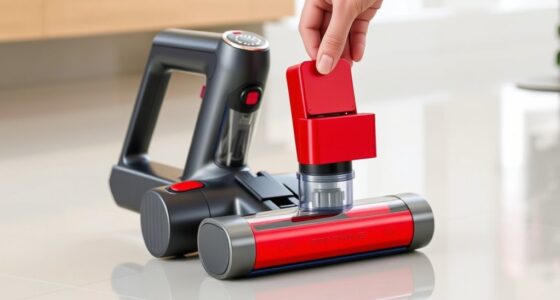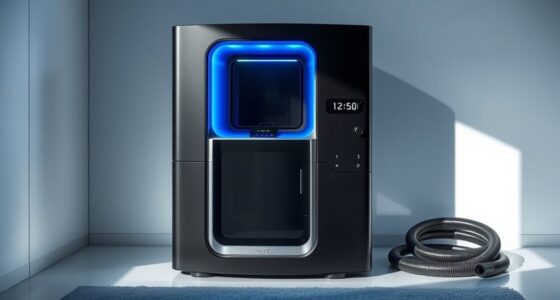To understand suction metrics, focus on three key measurements: air watts, CFM, and water lift. Air watts combine power and airflow to show overall efficiency, helping you see how well a vacuum converts energy into suction. CFM measures how much air moves, indicating airflow capacity, while water lift shows how strong the vacuum is at lifting heavy debris or fluids. Knowing how these metrics work together can help you pick the best equipment—continue to explore these details to make smarter choices.
Key Takeaways
- Air watts measure overall vacuum efficiency by combining suction power and airflow into a single metric.
- CFM indicates the volume of air moved per minute, affecting debris removal and surface coverage.
- Water lift assesses maximum lifting capacity, reflecting vacuum strength against heavy debris or liquids.
- High air watts suggest balanced, effective suction performance, while CFM and water lift highlight airflow and strength.
- Combining all three metrics provides a comprehensive understanding of a vacuum’s power and suitability for specific tasks.

Suction metrics are essential tools for measuring the strength and effectiveness of suction devices, whether in medical, industrial, or consumer applications. When evaluating these devices, understanding the key parameters—air watts, CFM, and water lift—helps you gauge their performance benchmarks and overall vacuum efficiency. These metrics serve as a foundation for comparing different models and ensuring you select the right equipment for your needs.
Air watts is a critical measure that combines suction power and airflow into a single value, providing a comprehensive view of a device’s vacuum efficiency. Unlike CFM or water lift alone, air watts reflects the overall ability of a vacuum to do work, making it a vital performance benchmark. For example, a higher air watt rating indicates that the device can generate more suction power for a given airflow, which is especially important in applications demanding strong, consistent performance. When assessing vacuum efficiency, focusing on air watts helps you understand how well a device converts energy into effective suction, rather than just looking at raw airflow or lift alone.
Air watts combine suction power and airflow for a complete vacuum efficiency assessment.
CFM, or cubic feet per minute, measures the volume of air a vacuum can move in a minute. This metric is particularly useful when you need to clear large debris or cover extensive surfaces quickly. However, CFM alone doesn’t tell the full story about vacuum efficiency. A high CFM with low water lift might result in weak suction, while a moderate CFM paired with high water lift could deliver stronger, more reliable vacuuming. Think of CFM as an indicator of airflow capacity—important for tasks requiring rapid movement of air but not the sole determinant of overall performance.
Water lift, also known as sealed or maximum suction, measures how high a vacuum can lift water or other fluids. It’s a direct indicator of the device’s ability to hold or pick up heavy debris, especially in industrial or cleaning settings. Water lift emphasizes vacuum strength in terms of pressure differential, making it a crucial performance benchmark when dealing with stubborn dirt or liquids. When comparing devices, higher water lift values suggest more robust suction, but it’s essential to consider this alongside air watts and CFM for a complete picture of vacuum efficiency. Additionally, understanding suction efficiency helps in choosing equipment that balances power and airflow for optimal results.
Frequently Asked Questions
How Do Suction Metrics Affect Vacuum Cleaner Maintenance?
Suction metrics directly impact your vacuum cleaner’s performance and maintenance routines. Higher air watts and CFM mean better suction, which can extend your vacuum’s lifespan by reducing strain on parts. Regularly checking these metrics helps you identify issues early, preventing motor burnout or clogging. By understanding and maintaining ideal suction levels, you keep your vacuum running efficiently longer, saving you money and effort on repairs and replacements.
Which Suction Metric Is Most Important for Pet Hair Removal?
When it comes to pet hair removal, you really want to hit the nail on the head. Air Watts are the most important suction metric for effective suction, as they measure overall power. Higher Air Watts mean better pet hair removal, especially on carpets and upholstery. CFM and Water Lift also matter, but focusing on Air Watts guarantees your vacuum has the strength needed to tackle stubborn pet hair.
Can Suction Metrics Vary Between Different Vacuum Brands?
You might notice suction metrics vary between vacuum brands, but brand consistency and measurement standardization influence this. Different manufacturers may use distinct testing methods, making direct comparisons tricky. To find the best vacuum for your needs, look beyond numbers and consider how well a brand adheres to standardized measurement practices. This guarantees you’re getting a reliable representation of suction power, especially important for tasks like pet hair removal.
How Do Environmental Conditions Influence Suction Measurements?
Environmental elements exert an evident effect on your vacuum’s efficiency. Poor air quality can clog filters, decreasing suction strength, while high noise levels might signal strain or malfunction. Temperature and humidity also impact suction measurements, causing fluctuations that can mislead your assessment. You’ll want to take into account these conditions to ensure your vacuum maintains maximum power, delivering the best clean with consistent suction, regardless of environmental challenges.
Are There Specific Suction Metrics Better for Industrial Applications?
You should focus on suction metrics that promote industrial efficiency and facilitate suction standardization. Air Watts is often the best choice because it combines airflow and power, giving a clear picture of performance. CFM and water lift are helpful but less exhaustive alone. For industrial applications, prioritize metrics that guarantee consistent performance and easy comparison across different systems, helping you optimize your equipment and meet standardization requirements effectively.
Conclusion
Now that you’ve explored air watts, CFM, and water lift, you see how each metric highlights a different aspect of suction power. Understanding these metrics helps you choose the right vacuum or cleaner for your needs. Recognize the importance of balance—considering power, airflow, and lift—to make smarter decisions. By knowing what each measure means, what each measure offers, and how they work together, you’re better equipped to select a device that truly meets your cleaning demands.









